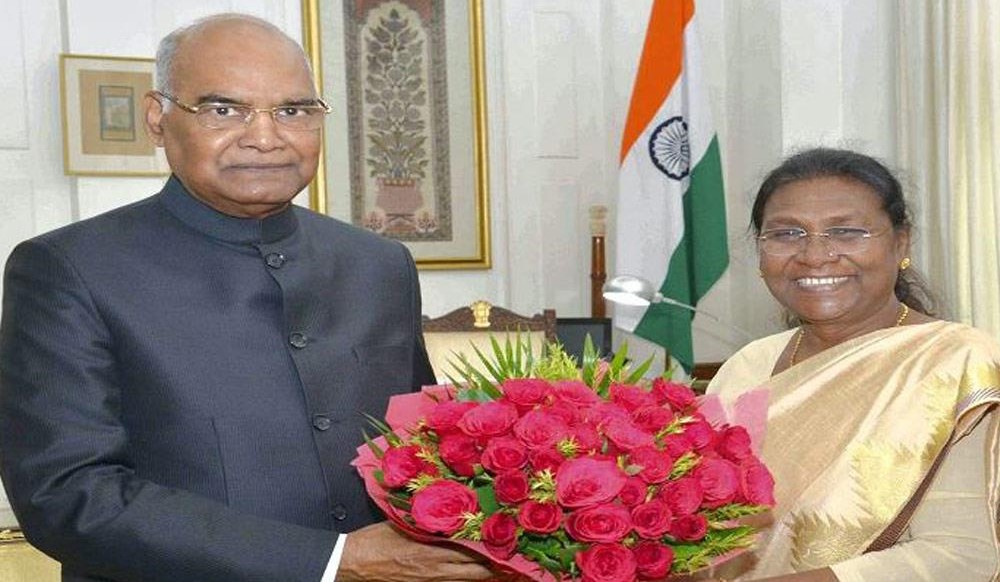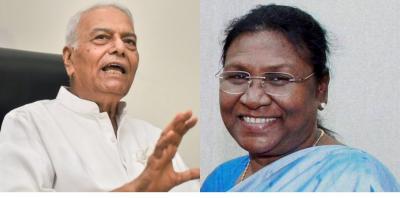Droupadi Murmu: A Tribal’s Tryst with Rashtrapati Bhavan

By Sudhir Kumar
The election of Droupdai Murmu as India’s first tribal President was a fait accompli with the majority of electors cutting across party lines in her favour. But it also brings to the fore the larger issue: whether her elevation as the First Citizen of the country will peter out into mere tokenism and a cosmetic exercise or give a determined push to the rather feeble efforts to mainstream the tribals who have been denied a judicious slice of the development cake. India can take lesson from Australia whose Prime Minister Kevin Rudd (2008) apologised on behalf of the country for the injustices meted out to the aborigines and promised to right the historical wrongs.
It did not require sparks of political punditry to know that in the 75th year of its independence, India would get its first tribal and second woman President, the day the ruling BJP-led National Democratic Alliance (NDA) announced that Droupadi Murmu would be its candidate for the country’s top constitutional post.

The victory of Murmu, a Santhal tribal from the eastern state of Odisha and former Jharkhand Governor who has now become the 15th occupant of the resplendent Rashtrapati Bhavan, was a given in view of the electoral calculus that was heavily stacked in favour of the NDA. She pipped to the post Yashwant Sinha, the opposition pick, by garnering 64 per cent votes of the Electoral College that elects India’s President. The victory margin was hefty as she garnered 6,76,803 votes against Sinha’s 3,80,177 votes.

The Election Commission said out of a total of 771 MPs (05 vacant) and 4,025 MLAs entitled to vote (06 vacant and 02 disqualified), 99.18 per cent cast their votes. Murmu received maximum votes from the Uttar Pradesh and Maharastra assemblies while Sinha got his largest share of support from West Bengal and Tamil Nadu.
Her victory heralds several firsts: she is the first President born after Independence. At 64, she is also the youngest occupant of Rashtrapati Bhavan, being younger by a month to the sixth President Neelam Sanjeeva Reddy who was 64 years and two months when he took office. Murmu will be 64 years and one month when she assumes office on July 25. Further, she has become the first President born in a tribal family and the second woman to hold the office after Pratibha Patil.
Murmu’s victory was sweetened by the fact that she got support from a section of opposition parties such as Odisha’s ruling party Biju Janata Dal (BJD), Shiv Sena, Jharkhand Mukti Morcha (JMM), Yuvajana Shramika Rythu Congress Party (YSRCP), Bahujan Samaj Party (BSP), All India Anna Dravida Munnetra Kazhagam (AIADMK), Telugu Desam Party (TDP), and Janata Dal (Secular). Some of these parties had earlier announced support for the joint opposition candidate Sinha, a former BJP MP who served as Finance Minister in the Atal Bihari Vajpayee government and was backed by Congress, Nationalist Congress Party (NCP), Aam Aadmi Party, Samajwadi Party, and Rashtriya Janata Dal (RJD) in the presidential race.
Surely, there were political imperatives for the BJP to field a tribal candidate as the saffron party is keen to bolster its presence among the tribal community in the upcoming assembly elections in Gujarat, Chhattisgarh, Rajasthan and Madhya Pradesh, which have a significant tribal population, besides the 2024 parliamentary polls. The party has also been trying to secure a firm toehold in Odisha’s tribal-dominated belt, ever since it snapped ties with the BJD in 2009. Odisha and Andhra Pradesh, which have also a sizeable tribal population, will be holding assembly elections along with the 2024 general elections, and the BJP is keen to curry favour with this segment of voters.
But that does not whittle away a wee bit from Murmu’s impressive personality who is no stranger to several firsts. She was born on June 20, 1958 in a Santhal tribal family in Uparabeda village of Mayurtbhanj, a remote and underdeveloped district in Odisha. Undaunted by the gruelling poverty that her family faced on a daily basis, she earned her Bachelor’s degree in Arts from Ramadevi Women’s College in Bhubaneswar, becoming the first girl in her village to go to college. She began her career as an honorary assistant teacher in Shri Aurobindo Integral Education Centre in Rairangpur and later as a junior assistant in the irrigation and power department in the Odisha government.
She cut her teeth into politics by becoming a municipal councillor from the Rairangpur Notified Area Council in Odisha in 1997 on a BJP ticket. Later, she was elected twice as an MLA and went on to become a minister in the BJD-BJP coalition government from 2000 to 2004, handling ministries such as transport, commerce, fisheries and animal husbandry. She was awarded the Nilkanth Award for the Best MLA of the year in 2007 by the state assembly. She contested the 2014 assembly election from Rairangpur, but lost to the BJD candidate. In 2015, she was appointed Governor of Jharkhand, again the first female tribal leader from Odisha to be appointed as a governor of an Indian state,and stayed in the post till 2021
If her life is strewn with sterling accomplishments, it has also been scarred by monumental personal tragedies. Within a span of six years (2009-15), she lost her banker husband, both the two sons in their twenties to accidents, mother and brother. Her only daughter works at a bank in Bhubaneswar and is married to rugby player Ganesh Hembram.
An unassuming and soft-spoken politician, Murmu is deeply spiritual and a practitioner of the meditation techniques of the Brahma Kumaris. In a 2016 interview to Doordarshan, she reminisced over the upheavals in her life when her son died in 2009. “I was devastated and suffered from depression. I spent sleepless nights after my son’s death. It was when I visited Brahma Kumaris, I realised I had to move on and live for my son and daughter,” she had said.
Her elevation is especially a matter of pride for Odisha which has 62 different tribal communities spread over 30 districts. They constitute 22.85 per cent of the total population of the state and contribute 9.17 per cent to the total tribal population of the country.
The moot point is: whether the election of Murmu will help improve the lives of Scheduled Tribes who have languished on the margins of society and developmental processes. Surely, her election as the First Citizen has immense symbolism. Although a titular head with the authority largely circumscribed by the provisions of the Constitution, the President’s words are heard and debated and the actions watched keenly. The tribal population now may become more emboldened to get their rightful place in the society.
There are some hopes, though. Murmu has shown political gumption in the past. In 2016, the Raghubar Das-led BJP government in Jharkhand had passed amendments to the Chotanagpur Tenancy (CNT), 1908 and Santhal Pargana Tenancy (SPT) Act, 1949, which would have ensured easy transfer of land for industrial use. Expectedly, it triggered protests by tribal communities across the state. Eight months later, Murmu, who was then the Jharkhand Governor, returned the laws asking the government to clarify how the amendments would benefit tribals. “Mere kalam se koi injustice nahi hoga (I will not let any injustice happen),” she had told a delegation of tribal leaders who called on her.
This surely needed some courage as the two-time former BJP MLA stood in the way of her own party government in Jharkhand. Political watchers had then predicted the end of her political career, but she survived without budging from her considered stand.
The fact is she commands a personality of her own which, at times, is at variance with the party’s stand. One instance is her admiration for the first Prime Minister Jawaharlal Nehru. At the start of the fifth session of the Jharkhand assembly in 2020, she said: “Pandit Jawaharlal Nehru once said, ‘By turning the portraits to the wall one cannot change the facts of the history’”. And she had never fought shy in expressing her views the tribal issues, a subject that she holds close to her heart.
A tribal President is the sign of the robustness of Indian democracy, but more action is needed on the ground to ameliorate the condition of tribals in the country. Though the President is largely viewed as a mere rubber stamp functionary, she can still give an impetus to policy formulation that would mainstream the marginalised tribals who constitute nearly 9 per cent — roughly numbering 13 crores (130 million) — of the country’s population ,
In 1999, the Atal Bihari Vajpayee government had created an independent ministry of tribal affairs that was carved out from the social justice ministry. The tribals have been granted political space but they have not reaped the benefits of economic progress. As per the UGC statistics, mere nine per cent of tribals reach graduation level and only 3 per cent students do postgraduate study. There are not many universities in tribal areas and fewer multispecialty hospitals.
Surely, Murmu does not have a magic wand to remove all the ills and problems that plague the tribal community. But India can learn from Australia which has now been trying to promote its indigenous people. In 2008, its Prime Minister Kevin Rudd issued a formal apology to them for the historic injustices they had suffered, and promised ‘…a future where we harness the determination of all Australians, Indigenous and non-Indigenous, to close the gap that lies between us in life expectancy, educational achievement and economic opportunity.’
Short URL: https://indiandownunder.com.au/?p=18191
